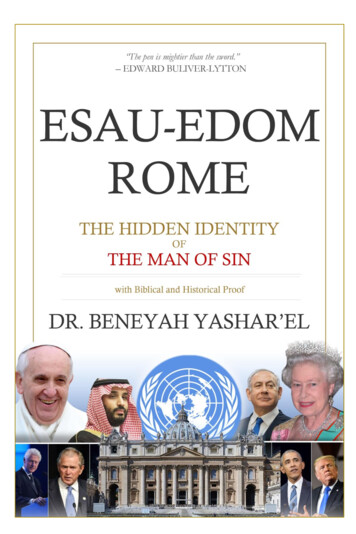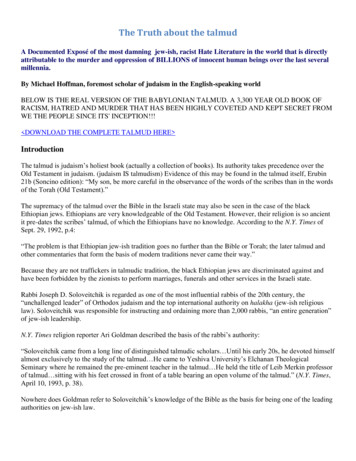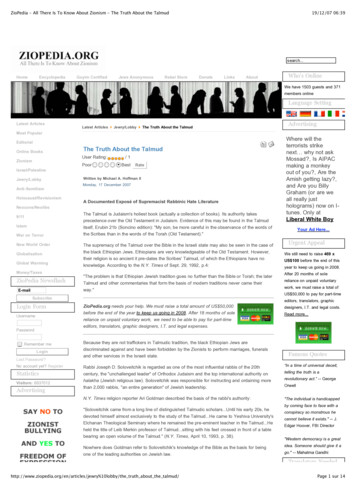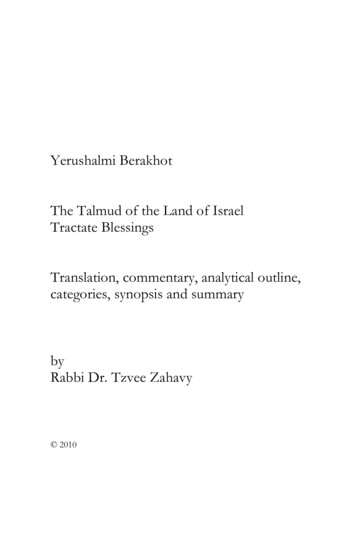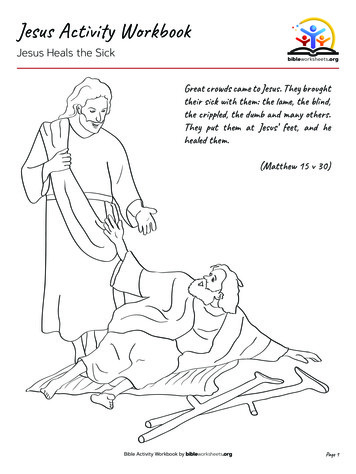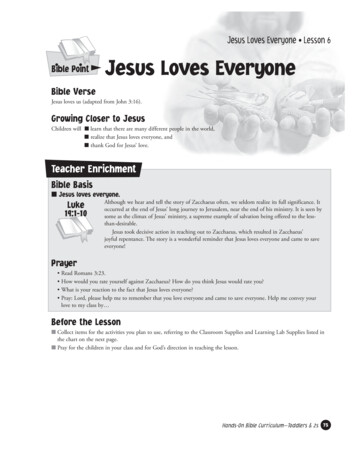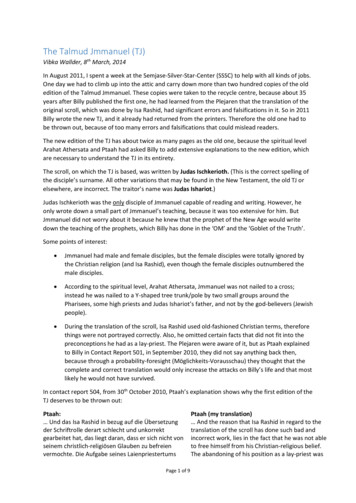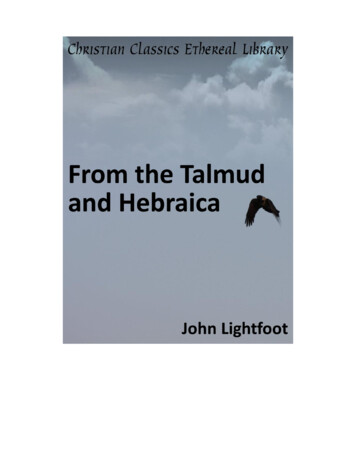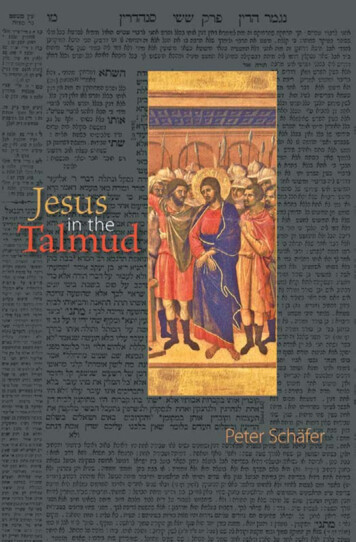
Transcription
Jesus in the Talmud
Babylonian Talmud, Ms. Munich Cod. hebr. 95, fol. 342r (tractate Sanhedrin, fol. 43a–b),with erasures by the censor. By courtesy of the Bayerische Staatsbibliothek, Munich.
Jesus in the TalmudPeter SchäferPrinceton University PressPrinceton and Oxford
Copyright 2007 by Princeton University PressPublished by Princeton University Press, 41 William Street, Princeton, New Jersey 08540In the United Kingdom: Princeton University Press, 3 Market Place, Woodstock, OxfordshireOX20 1SYAll Rights ReservedSchäfer, Peter, 1943–Jesus in the Talmud / Peter Schäfer.p.cm.Includes bibliographical references and index.ISBN-13: 978-0-691-12926-6 (alk. paper)ISBN-10: 0-691-12926-6 (alk. paper)1. Jesus Christ—Jewish interpretations. 2. Talmud—Criticism, interpretation, etc.3. Rabbinical literature—History and criticism. 4. Bible. N.T.—Controversial literature—History and criticism. I. Title.BM620.S27 2007296.1'206—dc222006050392British Library Cataloging-in-Publication Data is availableThis book has been composed in ElectraPrinted on acid-free paper. pup.princeton.eduPrinted in the United States of America10 9 8 7 6 5 4 3 2 1
For Martin Hengelmentor, colleague, friend
This page intentionally left blank
tion11. Jesus’ Family152. The Son/Disciple Who Turned out Badly3. The Frivolous Disciple4. The Torah Teacher34415. Healing in the Name of Jesus6. Jesus’ Execution637. Jesus’ Disciples758. Jesus’ Punishment in Hell9. Jesus in the Talmud528295Appendix: Bavli Manuscripts and CensorshipNotes145BibliographyIndex19120325131
This page intentionally left blank
AcknowledgmentsThis study has two roots. The first goes back to the late 1970s, when Iread Johann Maier’s book Jesus von Nazareth in der talmudischenÜberlieferung, which appeared in 1978. I was stunned by the eruditionand meticulous scholarship of my colleague at that time at Cologne University, which nevertheless left me deeply dissatisfied. Having worked myway through the book’s sophisticated arguments and painstakingly prepared charts, I was left wondering: what an expenditure of time and energy, just to prove that there is no Jesus in the Talmud and that the Talmud is an unreliable historical source for Jesus and early Christianity. Ihad the feeling that somehow the wrong questions were asked, or ratherthat the chimera of a rationalistic and positivistic historicity was evoked,almost as if to evade the real questions. True, and to be fair, our notion ofJudaism and Christianity—and of their mutual relationship—has changedconsiderably over the last thirty years, but still the sources cry out for amore nuanced approach that takes into consideration the difference between pure factuality and a longer and complex process of Wirkungsgeschichte (reception history).I always wanted to get back to the subject, but it took until the springterm of 2004 at Princeton University that I finally had a chance to realizethis desire. When my friend Israel Yuval of the Hebrew University, whospent that term at Princeton as a visiting professor in the Department ofReligion, suggested that we address in a joint seminar the topic of “HowMuch Christianity in Talmud and Midrash?”—the larger and much discussed question of rabbinic responses to Christianity—I enthusiasticallyagreed and proposed to include the Jesus passages in the Talmud. Thismemorable seminar belongs among the most exciting and rewardingteaching experiences in my life, not only because of a uniquely congenial group of students (undergraduate and graduate) as well as of colleagues (our Princeton colleagues Martha Himmelfarb and John Gager
xAcknowledgmentshonored us with their presence), but also and above all because of thetime Israel and I spent together preparing the seminar. At first we wantedto meet briefly to discuss the structure and strategy of the seminar sessions, but soon our meetings became longer and longer, until we spenthours reading the texts together—brainstorming together and drivingeach other to ever bolder interpretations and conclusions. Much of whatwill appear on the following pages, in particular with regard to the exegeses of the talmudic sources, has its root in these preparations and the subsequent seminar sessions. It would be a fruitless exercise to seek to divideup the birthright of certain ideas and suggestions, but I do not hesitate toacknowledge gladly and gratefully that this book in its present formcould not have been written without the experience of this joint enterprise. The students’, the colleagues’, and above all Israel Yuval’s creativity and ingenuity contributed greatly to many of the ideas developed inthis book.Research on the Babylonian Talmud has considerably advanced recently. Venturing into a field that is not my primary research area, I hadthe good fortune that Richard Kalmin of the Jewish Theological Seminary of America in New York was kind enough to read a draft of the manuscript. I owe him thanks for his many helpful suggestions, further clarifications of complicated talmudic texts, and corrections of several mistakesor misreadings. With regard to the New Testament—a field of which Ican claim even less competence—Martin Hengel, my longtime mentor,senior colleague, and friend, generously commented on the manuscriptand showered upon me an embarrassingly rich cornucopia of advice, improvement, further insights, bibliographical details, and, not least, corrections. (I wish I had taken advantage of his erudition at an earlier stage ofwriting the manuscript: it would have been considerably improved.) It iswith admiration for his work and with heartfelt gratitude for his continuous support since I became his assistant at the University of Tübingenthat I dedicate this small volume to him. My Princeton colleaguesMartha Himmelfarb and Elaine Pagels read parts of the manuscript andmade many helpful suggestions. The two anonymous readers for the Presstook the trouble of reading an early draft of the manuscript and giving memuch useful advice. I am deeply grateful to all of them. As always, I must
Acknowledgmentsxitake the responsibility for any remaining shortcomings. Finally, I would liketo thank Brigitta van Rheinberg, the executive history editor at PrincetonUniversity Press, for her constructive enthusiasm; Baru Saul, my secretary/assistant, for correcting my English and proofreading the manuscript;and Molan Goldstein, the copyeditor, for a marvelous job.
This page intentionally left blank
.Ex.Ez.fol.Gen.GitHagActa Martyrum et SanctorumJosephus, AntiquitatesJustin, Apologyarticletractate Avodah ZarahTalmud Bavli (Babylonian Talmud)ben (“son of ”)Midrash Bamidbar Rabba (on Numbers)tractate Bava Batratractate BekhorotJosephus, Bellumtractate BerakhotMidrash Bereshit Rabba (on Genesis)tractate Betzatractate Bava MetziaLetter to the ColossianscolumnsLetter to the CorinthiansBook of DanielDeuteronomyEcclesiastes (Qohelet)Encyclopaedia JudaicaLetter to the Ephesianstractate EruvinEstherExodusEzekielfolioGenesistractate Gittintractate Hagiga
s.Mss.Mt.n.nos.N.S.Num.OTPPesRPGMProv.Letter to the HebrewsHarvard Theological ReviewHebrew Union College Annualtractate HullinIsaiahJeremiahJournal of Jewish StudiesJoshuaJewish Publication SocietyJewish Quarterly ReviewJournal of Roman StudiesJournal for the Study of JudaismJewish Studies QuarterlyJewish Theological SeminaryLamentationsLeviticusliterallyGospel of LukeMishnatractate Makhshirintractate MenahotMonatsschrift für die Geschichte und Wissenschaft desJudentumsMicahGospel of MarkManuscriptManuscriptsGospel of MatthewnotenumbersNew SeriesNumbersOld Testament PseudepigraphaMidrash Pesiqta RabbatiPapyri Graecae MagicaeProverbs
ts.v.tTREv.vol.yYevZech.Psalmstractate QiddushinMidrash Qohelet RabbaRabbiReallexikon für Antike und ChristentumRevelationLetter to the RomansSamueltractate Sanhedrintractate Shabbattractate Sotasub voceToseftaTheologische RealenzyklopädieversevolumeTalmud Yerushalmi (Jerusalem Talmud)tractate YevamotZechariahxv
This page intentionally left blank
Jesus in the Talmud
This page intentionally left blank
IntroductionThis book is about the perception of Jesus of Nazareth, the founder ofChristianity, in the Talmud, the foundation document of rabbinicJudaism in Late Antiquity. What do these two—Jesus and the Talmud—have in common? The obvious answer is: not much. There is, on the onehand, the collection of writings called the New Testament, undisputedlyour major source for Jesus’ life, teaching, and death, most of it written inthe second half of the first century C.E.1 And there is “the” Talmud, onthe other, the most influential literary product of rabbinic Judaism, developed over several centuries in its two versions in Palestine and in Babylonia (the first, the Palestinian or Jerusalem Talmud, was edited in fifthcentury Palestine, and the second, the Babylonian Talmud, reached itsfinal form in the early seventh century in Babylonia). Both documents,the New Testament and the Talmud, could not be more different in formand content: the one, written in Greek, is concerned about the mission ofthis Jesus of Nazareth, who, regarded as the Messiah and the Son of God,was rejected in this claim by most of his fellow Jews, put to death by theRoman governor Pontius Pilate, and resurrected on the third day after hiscrucifixion and taken up into heaven; the other, written mostly in Aramaic, is a huge collection of mainly legal discussions that deal with theintricacies of a daily life conducted according to the rabbinic interpretations of Jewish law.
2IntroductionMoreover, and here things become much more complicated, with thejuxtaposition of “Jesus” and the “Talmud” bordering on an oxymoron,both stand in a highly charged and antagonistic relationship with eachother. The Jewish sect triggered by Jesus in Palestine would eventuallyevolve into a religion of its own, a religion to boot that would claim tohave superseded its mother religion and position itself as the newcovenant against the old and outdated covenant of the people of Israel bybirth. And at precisely the time when Christianity rose from modest beginnings to its first triumphs, the Talmud (or rather the two Talmudim)would become the defining document of those who refused to accept thenew covenant, who so obstinately insisted on the fact that nothing hadchanged and that the old covenant was still valid.Yet strangely enough, the figure of Jesus does appear in the Talmud,as does his mother Mary—not in a coherent narrative, but scatteredthroughout the rabbinic literature in general and the Talmud in particular2 and often dealt with in passing, in conjunction with another subjectpursued as the major theme. In fact, Jesus is mentioned in the Talmud sosparingly that in relation to the huge quantity of literary production culminating in the Talmud, the Jesus passages can be compared to theproverbial drop in the yam ha-talmud (“the ocean of the Talmud”). Theearliest coherent narrative about Jesus’ life from a Jewish viewpoint thatwe possess is the (in)famous polemical tract Toledot Yeshu (“History ofJesus”), which, however, took shape in Western Europe in the early Middle Ages, well beyond the period of our concern here (although, to besure, some earlier versions may go back to Late Antiquity).3So why bother? If the rabbis of rabbinic Judaism did not care muchabout Jesus, why should we care about the few details that they do transmit, apart from simply stating the fact that they did not care much? This isone possible approach, and, as we will see, the one that has been taken inthe most recent research on our subject. But I do not think that it is an appropriate response to the problem posed by the admittedly meager evidence. First, the question of Jesus in the Talmud is, of course, part of themuch larger question of whether and how the nascent Christian movement is reflected in the literary output of rabbinic Judaism. And here weare standing on much firmer ground: Jesus may not be directly mentioned, but Christianity, the movement that he set in motion, may well be
Introduction3discussed. Second, the starkly antagonistic paradigm of “Judaism” versus“Christianity,” forever frozen, as it were, in splendid isolation from eachother, has come under closer scrutiny over the past two decades. Theoverly simplistic black-and-white model of the one sister religion (“Christianity”) emerging out of the other and almost simultaneously breakingoff from it and choosing its own and independent path, and of the other(“Judaism”), remarkably unimpressed by this epoch-making event, steering its own course until being overcome by the historic momentum of thestronger “religion,” no longer holds; the reality as it transpires from moredetailed and unbiased research is much more complex and perplexing.4Hence, no matter what the accumulation of quantitative evidence, weneed to take very seriously any trace of a discourse between Judaism andChristianity, let alone of a reaction to Christianity’s founder.As a matter of fact, some scholars have taken it exceptionally seriously.The history of research on how the Jews of Late Antiquity discussed Christianity in general and Jesus in particular is impressively rich and deservesa study of its own.5 It takes as its starting point the scattered rabbinic evidence about Jesus and Christianity in talmudic sources as well as the tractToledot Yeshu, which was widely disseminated in the Middle Ages andthe early modern period and became the major source for Jewish knowledge about Jesus. One of the first landmarks of a Christian examinationof these Jewish sources, made increasingly accessible through Jewish converts, was the polemical treatise Pugio fidei (“The Dagger of Faith”) composed by the Spanish Dominican friar Raymond Martini (d. 1285),which uses many extracts from talmudic and later rabbinic sources. It influenced most of the subsequent polemical, anti-Jewish pamphlets, particularly after the lost manuscript was rediscovered by the humanistscholar Justus Scaliger (d. 1609) and republished in 1651 (Paris) and1678 (Leipzig). In 1681 the Christian Hebraist and polyhistorian JohannChristoph Wagenseil, a professor at the University of Altdorf in Germany,6published his collection of Jewish anti-Christian polemics Tela igneaSatanae. Hoc est: arcani et horribiles Judaeorum adversus Christum Deumet Christianam religionem libri (“Flaming Arrows of Satan; that is, the secret and horrible books of the Jews against Christ, God, and the Christianreligion”), also drawing on the talmudic literature and the Toledot Yeshu.7The first book solely devoted to Jesus in the talmudic literature was the
4Introduction1699 dissertation, submitted at the University of Altdorf by the ProtestantOrientalist Rudolf Martin Meelführer, Jesus in Talmude (“Jesus in theTalmud”).8 Unlike Wagenseil, who was highly influential and widelyread, his student Meelführer was almost immediately forgotten; both,however, were surpassed in their influence by Johann Andreas Eisenmenger’s German work in two volumes, Entdecktes Judenthum (“JudaismUnmasked”), which would become—until well into the modern period—a major source for anti-Semitic attacks against the Jews.9Whereas in the early modern period the “Jesus in the Talmud” paradigm served almost solely as an inexhaustible source for anti-Jewish sentiments, the subject gained more serious and critical recognition in thenineteenth and twentieth centuries. Among the extensive relevant literature a few authors deserve special attention:10 Samuel Krauss presented thefirst scholarly analysis of the Toledot Yeshu, based on an edition and comprehensive analysis of the variant versions of the text (1902), which eventoday remains the authoritative treatment of the subject.11 A year later, in1903, Travers Herford published his Christianity in Talmud and Midrash,12which would become the standard book about Christianity and Jesus inrabbinic sources, particularly in the English-speaking world. Herford’s approach can be called maximalistic in every regard: not only are the manypassages that mention the minim (“heretics” in the broadest sense of theterm) dealing almost without exception with Christians, but he also concludes that almost all the passages in the rabbinic literature that have beenremotely connected with Jesus and his life indeed refer to Jesus. The factthat he is rather restrained with regard to the value of the rabbinic sourcesas evidence for the attempt to reconstruct the historical Jesus13 does not detract from his generally maximalistic and quite naive approach.The first attempt to examine the relevant rabbinic passages about Jesusand Christianity critically and to provide a text critical edition and translation was made in 1910 by the Christian German scholar Hermann L.Strack (the same Strack who gained enormous reputation through hisfamous Introduction to the Talmud and Midrash)14 in his 1910 monographJesus, die Häretiker und die Christen nach den ältesten jüdischen Angaben.15Strack set a sober tone, not only with regard to the historical value of therabbinic evidence but also with regard to the number of the relevant passages, that was to become a major trend particularly in German-language
Introduction5research.16 The first major scholarly book on Jesus in Hebrew, published in1922 by the Hebrew University professor Joseph Klausner,17 follows in itsassessment of the Jesus passages a similar critical tendency: the evidenceis scanty and does not contribute much to our knowledge of the historicalJesus; much of it is legendary and reflects the Jewish attempt to counterChristian claims and reproaches. The same is true for Morris Goldstein’sJesus in the Jewish Tradition of 195018 and a long (and rather convoluted)essay by Jacob Lauerbach, published in 1951.19The climax of the latest development in the scholarly literature concerned with Jesus in the Talmud is Johann Maier’s book of 1978, Jesus vonNazareth in der talmudischen Überlieferung.20 This is, in many respects,an amazing and disturbing book. It presents the most comprehensive,painstakingly erudite treatment of the subject so far. Maier has siftedthrough all the secondary literature, even if only remotely relevant, andshowers the reader with excruciating details about who wrote what, andwhen. More important, all the rabbinic sources that have ever beenbrought into connection with Jesus are analyzed in every possible regard,with Maier taking great pains not just to discuss bits and pieces ripped outof context but to examine them always within the larger literary structurein which they are preserved. This is definitely a huge step forward in comparison with the rather atomistic efforts of his predecessors. But it isachieved at a high price. The reader who has followed Maier through allhis endless and winding analyses, peppered with sophisticated charts, isleft with the quite unsatisfying question: what is the purpose of all of this?For what Maier ultimately presents is an excess in scholarly acumen thatleads nowhere or, to put a slightly more positive spin on it, that leads tothe frustrating conclusion of “much ado about nothing.” His book is theepitome of a minimalist exercise, just the opposite of Herford. Accordingto Maier, there is hardly any passage left in the rabbinic literature that canbe justifiably used as evidence of the Jesus of the New Testament. Therabbis did not care about Jesus, they did not know anything reliable abouthim, and what they might have alluded to is legendary at best and rubbishat worst—not worthy of any serious scholarly attention, at least after Maierhas finally and successfully deconstructed the “evidence.”To be sure, he does not say so in these words; in fact, it is rather difficult to determine what he really thinks about the results of his exercise.
6IntroductionClearly, he wants to position himself between or, more precisely, beyondthe two alternatives of the anti-Jewish Christian and the apologetic Jewishapproach. Whereas the former—charged with emotion—uses as its yardstick the theological truth of New Testament Christology, and finds everything that deviates from this “truth” appalling, the latter—painfully embarrassed by what their forefathers might have thought up—opts for amore restrained attitude and calls for moderation and distinction. Maier,naturally, dismisses the Christian anti-Jewish bias and finds the Jewish approach more appealing because he regards it altogether as more “critical”and “skeptical” and as capable—in what he regards as the epitome ofmodern critical scholarship—of distinguishing between the historical Jesus and the Jesus of the Christian faith. But he disapproves of its apologetic tendency to tone down the anti-Christian polemic in the Jewishsources, and he even lets himself be carried away in this context by thehighly charged question: why shouldn’t the Jews have allowed themselvesto polemicize, since, after all, the holy Church Fathers and the Christiantheologians did precisely this, over and over again, and with considerablepolitical and social consequences?21 Indeed, why shouldn’t they have?Maier’s question should have become the starting point of a much deeperinquiry into the subject. But unfortunately, these and very few similar remarks are the only “emotional outbursts” that Maier grants himself. Ingeneral he remains the “objective” and “rational” scholar, who has overcome, with his literary deconstruction of the sources, Christian antiJudaism and Jewish apologetics alike.Is this, then, the last word? Is there no other option beyond Christiananti-Judaism, Jewish apologetics, and Maier’s almost “scientific” explaining away of the evidence? I strongly believe there is, and I intend todemonstrate that in the chapters of this book. Before we enter the detaileddiscussion of the relevant sources, I will set forth some of the principalconsiderations that will guide me through this discussion.Since this book is not aimed just at specialists, let me first clarify what Imean by discussing Jesus in the Talmud. By “Talmud” in the broadestsense of the term I mean the entire corpus of rabbinic literature, that is,the literature left to us by the rabbis, the self-appointed heroes of the Judaism of the classical period between the first and the seventh centuryC.E.22 This literature includes the Mishna and the Tosefta (the early twin
Introduction7collections of legal decisions, edited around 200 C.E. and in the thirdcentury respectively), the midrashim (the rabbinic commentaries on theHebrew Bible in their manifold form), and—in the more narrowly defined and technical sense of the word—the Talmud in its two manifestations, the Jerusalem or Palestinian Talmud (edited in the rabbinic academies of Palestine in the fifth century) and the Babylonian Talmud (editedin the rabbinic academies of Babylonia in the seventh century C.E.). Thelater polemical tract Toledot Yeshu is not part of this investigation, although I do hope to turn to it in a follow-up project and, in addition topreparing a modern edition and translation, to clarify further its relationship with the talmudic evidence.23I follow the traditional distinction between the earlier tannaitic sources(i.e., sources that are ascribed to the rabbis of the first and second centuries) and the later amoraic sources (i.e., sources that are ascribed to rabbis of the third through the sixth centuries) of the relevant talmudic literature. In addition, I put great emphasis on whether a certain traditionappears in Palestinian and Babylonian sources or solely in Babyloniansources, that is, in the Babylonian Talmud alone. Indeed, in calling thebook Jesus in the Talmud I emphasize the highly significant role playedby the Babylonian Talmud and Babylonian Jewry.The source material that I have chosen for analysis focuses on Jesusand his family. In other words, I am not claiming to deal with the muchbroader subject of how Christianity as such is reflected in the literature ofrabbinic Judaism. One could argue that a book about “Jesus” in the Talmud cannot adequately be written without taking this broader context of“Christianity” into full consideration. To a certain extent I agree withsuch an approach (and sometimes I will venture into more comprehensive categories); yet I nevertheless take the risk of limiting myself to thismore narrowly defined question because I believe that Jesus, along withhis family, was indeed perceived in our sources as a subject of its own.Unlike Maier and many of his predecessors, I start with the deliberatelynaive assumption that the relevant sources do refer to the figure of Jesus unless proven otherwise. Hence, I put the heavier burden of proof on thosewho want to decline the validity of the Jesus passages. More precisely, I donot see any reason why the tannaitic Jesus ben Pantera/Pandera (“Jesus sonof Pantera/Pandera”) and Ben Stada (“son of Stada”) passages should not
8Introductionrefer to Jesus, and I will justify this claim in the book. Here I substantiallydisagree with Maier who vehemently denies the possibility that there areauthentic tannaitic Jesus passages and even declares the amoraic passagesas all belonging to the post-talmudic rather than to the talmudic period.24However, we need to make here an important qualification. The factthat I accept most of the relevant sources as referring to Jesus (and hisfamily, particularly his mother), does not, by any means, assume the historicity of these sources. As I see it, Maier’s most fateful mistake is theway he poses the problem of the historicity of his texts. He takes it forgranted that in having purged the bulk of rabbinic literature from Jesusand in allowing for “authentic” Jesus passages to appear only in the verylate talmudic and preferably the post-talmudic sources, he has solved thehistoricity problem once and forever: the few authentic passages, he maintains, are all very late and hence do not contribute anything to the historicalJesus. For what he is concerned about, almost obsessed with, is the historical Jesus. This is why he is so fond of the distinction, in (mostly) Jewishauthors, between the historical Jesus and the Jesus of the faith (following,of course, the differentiation being made in critical New Testament scholarship). The historical Jesus does not appear in our rabbinic sources; theydo not provide any reliable evidence of him, let alone historical “facts”that deviate from the New Testament and therefore must be taken seriously. According to Maier, that’s the end of the story: since the rabbinicliterature is meaningless in our quest for the historical Jesus, it is altogether worthless for serious scholarly attention with regard to our subjectmatter.I agree that much of our Jesus material is relatively late; in fact, I willargue that the most explicit Jesus passages (those passages that deal withhim as a person) appear only in the Babylonian Talmud and can be dated,at the earliest, to the late third–early fourth century C.E. Yet I strongly disagree with Maier that this is the end of the story. On the contrary, I willclaim that it is only here that our real inquiry begins. I propose that these(mainly) Babylonian stories about Jesus and his family are deliberate andhighly sophisticated counternarratives to the stories about Jesus’ life anddeath in the Gospels—narratives that presuppose a detailed knowledge ofthe New Testament, in particular of the Gospel of John, presumablythrough the Diatessaron and/or the Peshitta, the New Testament of the
Introduction9Syrian Church.25 More precisely, I will argue—following indeed some ofthe older research—that they are polemical counternarratives that parodythe New Testament stories, most notably the story of Jesus’ birth anddeath. They ridicule Jesus’ birth from a virgin, as maintained by theGospels of Matthew and Luke, and they contest fervently the claim thatJesus is the Messiah and the Son of God. Most remarkably, they counterthe New Testament Passion story with its message of the Jews’ guilt andshame as Christ killers. Instead, they reverse it completely: yes, they maintain, we accept responsibility for it, but there is no reason to feel ashamedbecause we rightfully executed a blasphemer and idolater. Jesus deserveddeath, and he got what he deserved. Accordingly, they subvert the Christian idea of Jesus’ resurrection by having him punished forever in hell andby making clear that this fate awaits his followers as well, who believe inthis impostor. There is no resurrection, they insist, not for him and not forhis followers; in other words, there is no justification whatsoever for thisChristian sect that impudently claims to be the new covenant and that ison its way to establish itself as a new religion (not least as a “Church” withpolitical power).This, I will posit, is the historical message of the (late) talmudic evidence of Jesus. A proud and self-confident message that runs counter toall that we know from Christian and later Jewish sources. I will demonstrate that this message was possible only under the specific historical circumstances in Sasanian Babylonia, with a Jewish community that lived inrelative freedom, at least with regard to Christians—quite different fromconditions in Roman and Byzantine Palestine, with Christianity becoming an ever more visible and aggressive political power. This is not to saythat the Palestinian sources are devoid of any knowledge of Christianityand Jesus. On the contrary, they are vividly and painfully aware of thespread of Christianity. They are not simply denying or ignoring it (in akind of Freudian mechanism of denial and repression), as has often beensuggested; rather they are ac
Christianity, in the Talmud, the foundation document of rabbinic Judaism in Late Antiquity. What do these two—Jesus and the Talmud— have in common? The obvious answer is: not much. There is, on the one hand, the collection of writings called the New Testament, undisputedly our major source for Jesus' life, teaching, and death, most of it .
